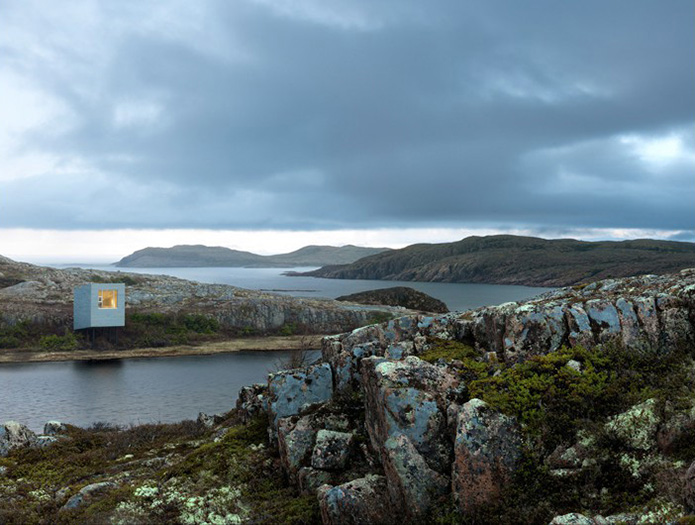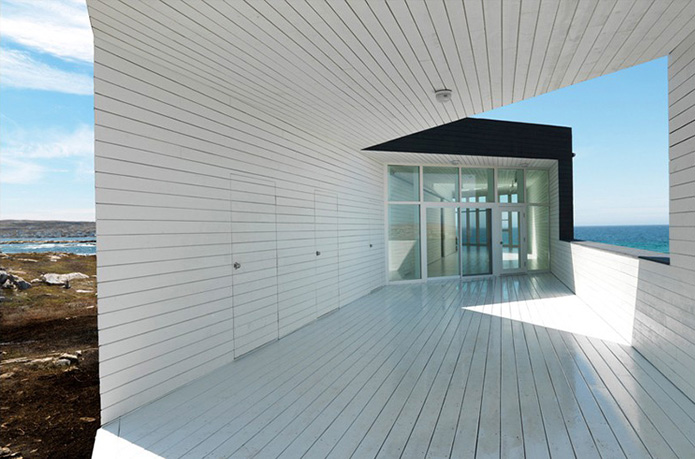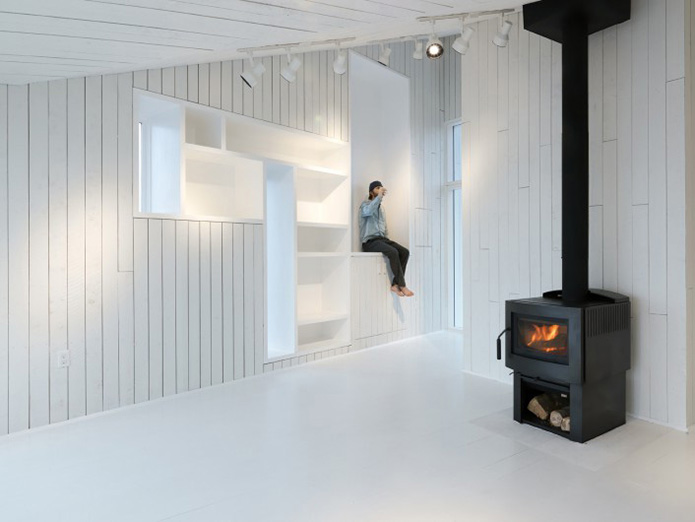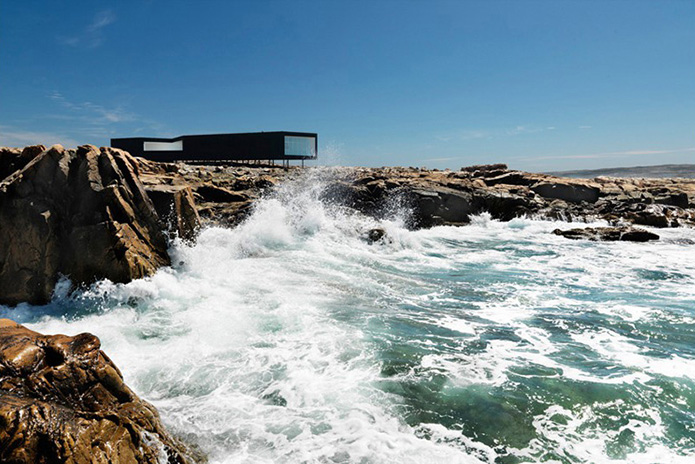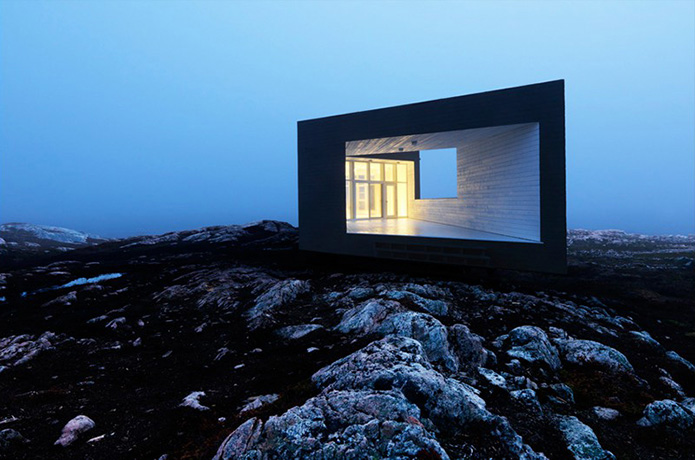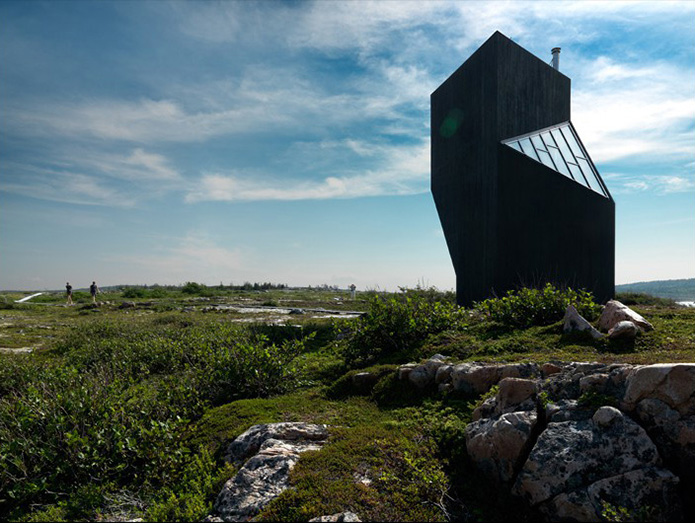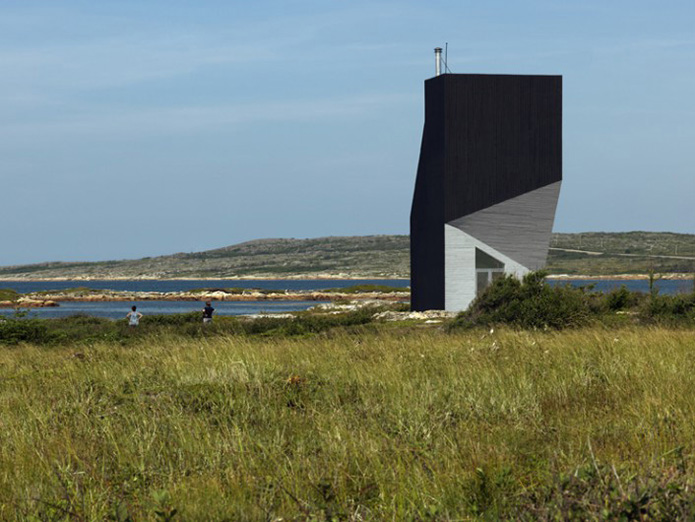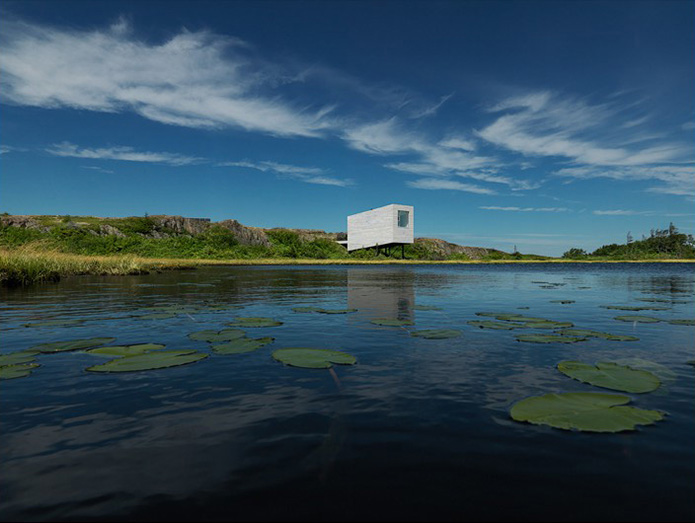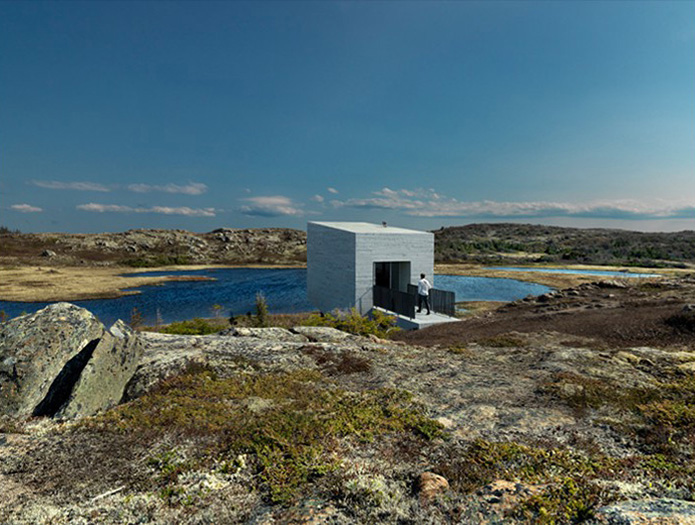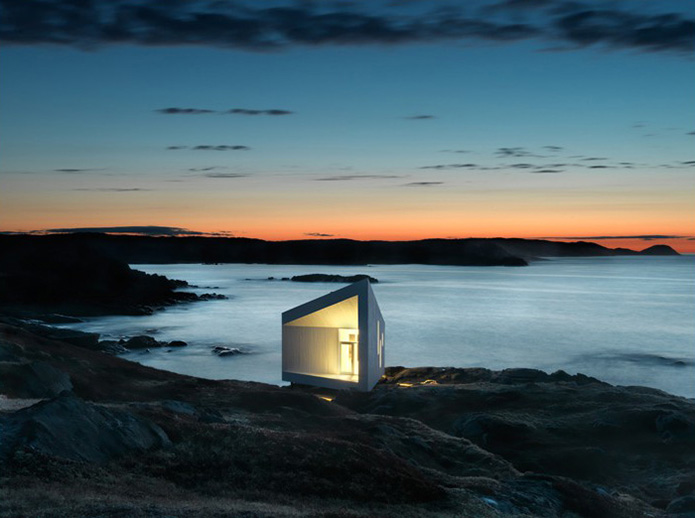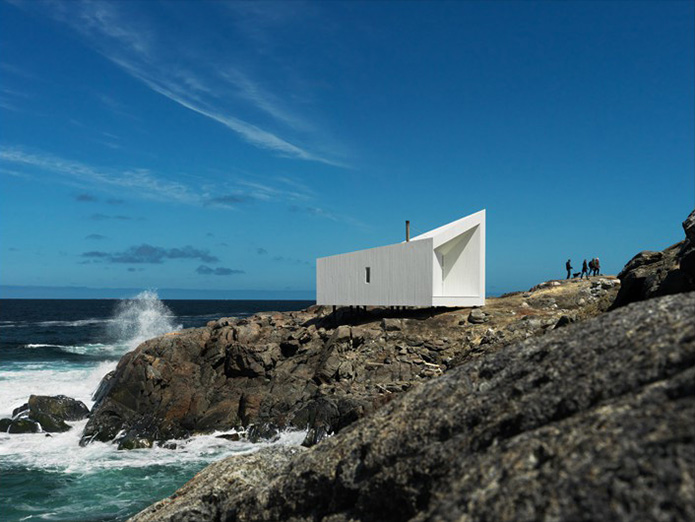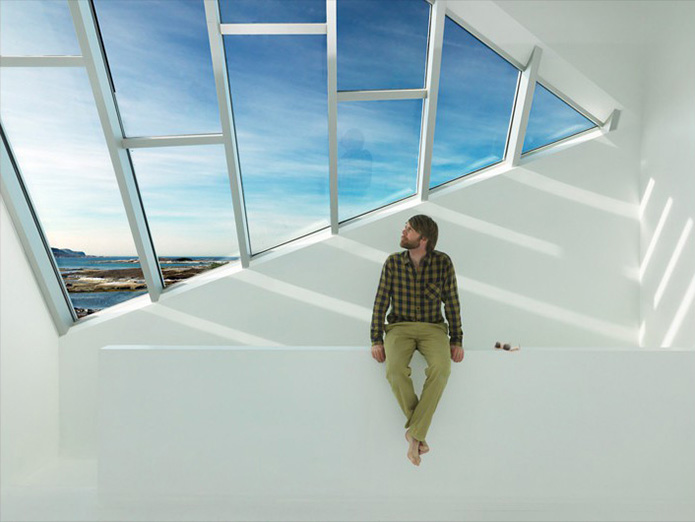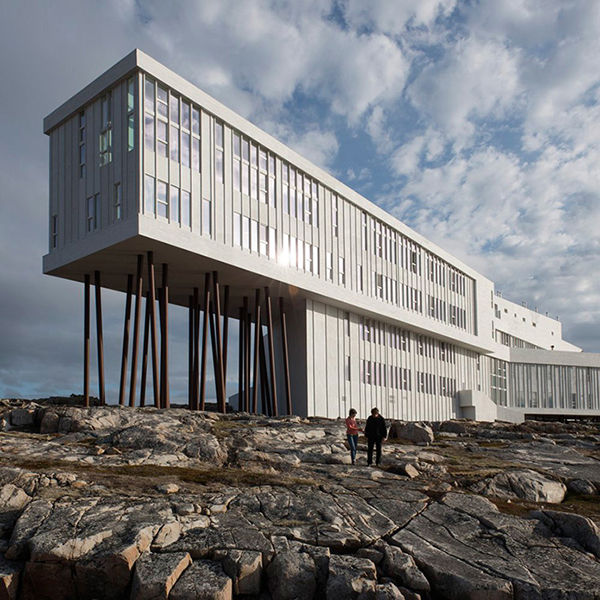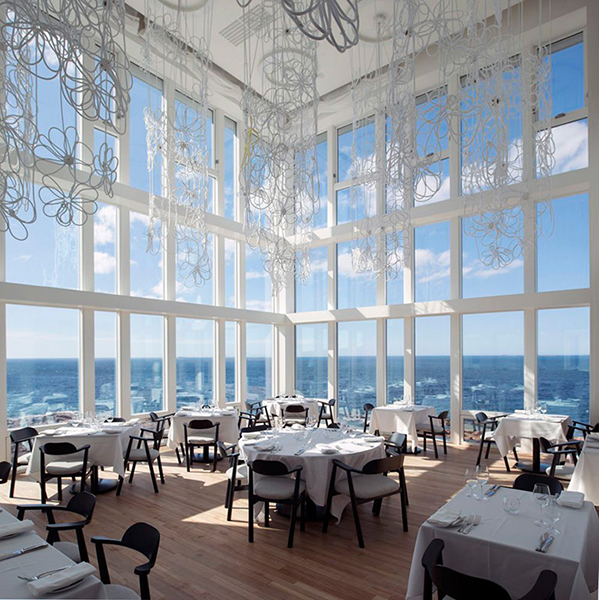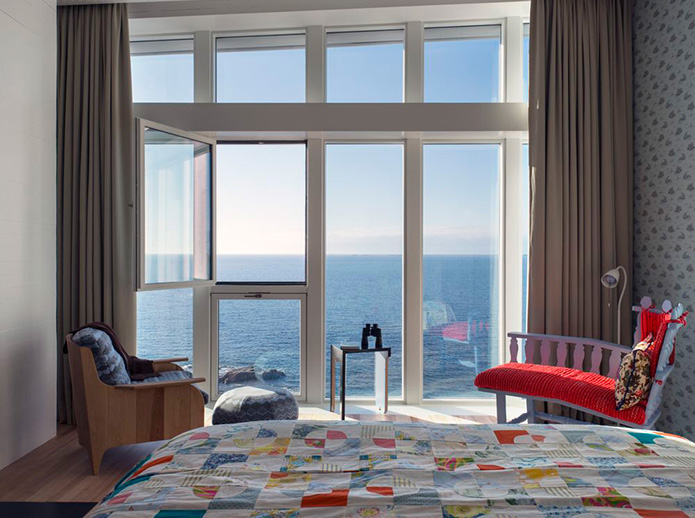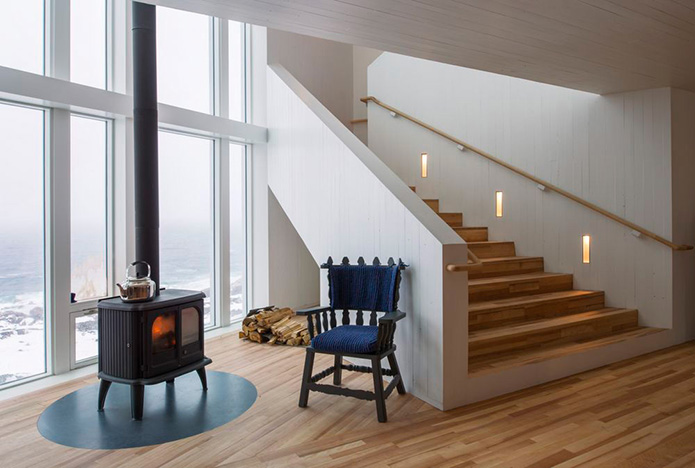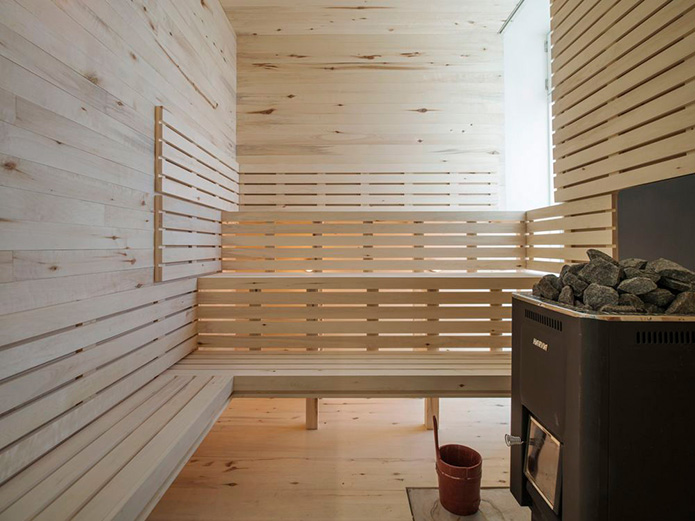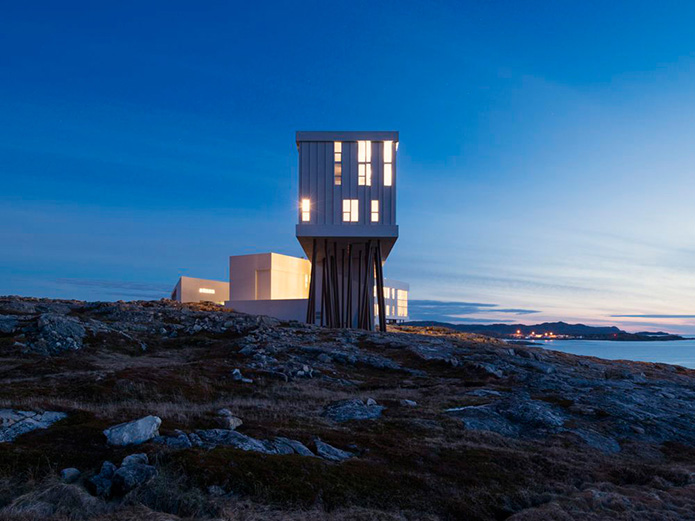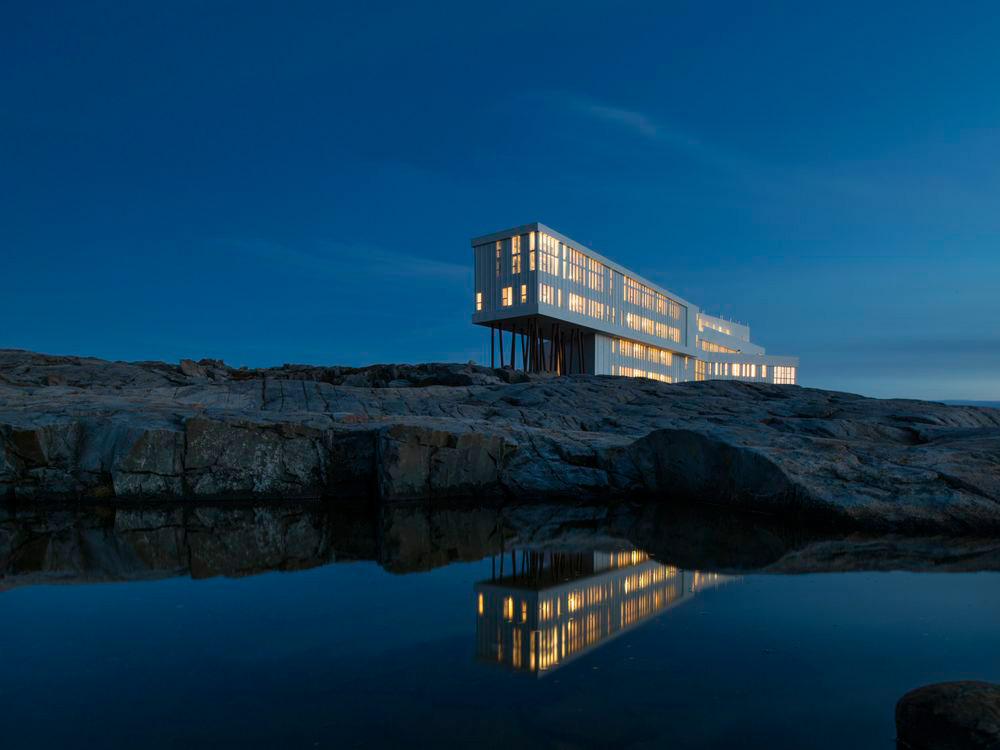
Image © Fogo Island Inn.
To be on an island, at the mercy of nature’s elements, its power and beauty, is often an experience that nurtures the soul. Walking on a deserted beach, hair tussled by the cold Atlantic wind, you draw your coat tighter, breathe a little deeper, aware of the soft sand beneath your feet, the roar of crashing waves, the jutting rocky outcrops. These surroundings are organic and pure, not planned or designed. Yet such a landscape provides a creative platform; one with which the designer and architect can juxtapose a well considered structure or form.
On a small island named Fogo, a faraway place that is 45 minutes by ferry from the northeastern coast of Newfoundland, Canada, something magical has been taking place. A series of contemporary structures have appeared in discrete locations around the island and are bringing a sense of otherworldliness to this majestic and barren landscape.
Todd Saunders, a Newfoundland born and Norwegian-based architect, works with a creative vision of buildings that test architecture’s application to natural environments. His architectural practice is one that explores vernacular materials and techniques, repurposing them in unforeseen ways. Saunders has cleverly placed a sequence of modern artists’ studios and an Inn upon Fogo Island’s raw natural terrain. These structures allude to the clean lines of both Nordic and Japanese architecture and are designed to be of the island, a part of it’s dramatic and isolated beauty. They are places whose intended purpose is to stimulate the senses, deliberately isolated in order to bolster creativity, reflection and thinking.
“Newfoundland has a different, very rough kind of beauty. The landscape appears harsh, but it is also fragile. Architecture has to sit lightly on the land, yet also become a part of it.” (Source: Todd Saunders, Architecture in Northern Landscapes. Birkhäuser).
Fogo’s remoteness has meant its islanders have depended mainly on fishing for their livelihoods. As with many fishing communities across the world, they have experienced depleted fish stocks and an imposed government embargo on fishing for cod (once the island’s main fish source). Making life more difficult, there is an over-reliance on older generations to maintain the fishing industry; young people tend to leave Fogo upon completing their schooling.
In a concerted effort to secure a healthier future for Fogo Island, the building of a succession of artists’ studios and the Fogo Island Inn are transforming the fortunes of this traditional fishing locale. One of the leading lights in this new journey is social entrepreneur Zita Cobb, an island native who, like many younger islanders, left Fogo aged 16 upon completing her schooling. Cobb eventually went on to enjoy success in Silicon Valley as a fibre optics entrepreneur, before taking the decision to return to Fogo in the early 2000s having established the Shorefast Foundation. Shorefast is a charity that believes wholeheartedly in community and social entrepreneurship. It values heritage, a future for rural communities built on innovation and the power of the arts as a protagonist for change.
The Shorefast Foundation has invested in its belief that the arts will play a central role in realising the sustainability of Fogo Island. The artists’ studios, as designed by Todd Saunders, are located at varying points across Fogo. The main building material is wood and construction techniques make reference to local traditions.
“These buildings are strangely familiar, in the sense that their forms might be unconventional, but on closer inspection they reveal traditional methods and materials.” (Source: Todd Saunders, Architecture in Northern Landscapes. Birkhäuser).
Artists and thinkers hailing from diverse disciplines, coming from Canada and around the world, are able to live and work on Fogo for varied amounts of time. They reside in restored traditional Newfoundland wooden saltbox houses and work in one of the studios, whose names are Long, Tower, Bridge and Squish. The studios are solar powered, each one having a biodegradable toilet and wood burning stove.
Long Studio was the first to be completed in 2010. It is sited on the seaside and stretches towards the water, its windows framing magnificent sea views.
Tower Studio was completed in 2011. Its origami-type structure looks like a distorted tower, giving it a unique presence on the horizon. The studio can only be accessed using a long timber boardwalk.
Bridge Studio was completed in 2011 and is one of the smallest of the artists’ studios. It was envisaged as a setting for contemplation. A five metre long bridge connects the structure to a nearby hillside.
Squish Studio was completed in 2011 and is a distorted trapezoidal edifice. Due to the harsh and uneven ground on which it sits, the studio is raised on pillars to ensure it remains level. This affords Squish incredible views.
“These studios are about the relationship between building, land, and ocean. The whole project faces north, oriented toward the Atlantic coast.” (Source: Todd Saunders, Architecture in Northern Landscapes. Birkhäuser).
The walk to each studio, their locations deliberately isolated, is intended to create a sense of slowing down and meditation before embarking on the day’s work. The location of both the studios and artists’ homes was calculated in such a way as to help bring together artists and islanders; indeed artists-in-residence are encouraged to engage in artistic endeavours with Fogo’s islanders. Collaborative projects thus far have included films and furniture designs informed by local traditions. There is in addition a Fogo Island Arts Education programme that encompasses art and film-making workshops for the island’s residents, led in the main by artists-in-residence.
Zita Cobb believes that cultural resilience is key to securing Fogo Island’s identity. In an interview with Monocle, Cobb observes: “Culture is how we know who we are. I think art and artists have a critical thinking and a way of knowing from an original source. We live in such an overwhelming amount of information that it’s impossible to extract knowledge from it and even more difficult to extract wisdom. And so I think the combination of contemporary art, critical thinking and the traditional wisdom that’s innate in a place, in a people, is a powerful [one].”
The bold yet strikingly relevant Fogo Island Inn, designed by Todd Saunders and completed in late 2013, provides employment opportunities on the island and opens it up to the somewhat more adventurous tourist.
The timber-clad Inn is built on stilts, its structure a gesture to the architectural expression of the island’s houses and its traditional fishing ‘stages’ (small sheds used to store fish that are balanced above the water on wooden piers). Fogo Island Inn was named as one of ‘ten daring new buildings around the world’ by Architectural Digest.
The Inn has 29 guest suites that provide vistas of the often vigorous North Atlantic Ocean. With an emphasis on home, charm and comfort, all textiles and furnishings at the Inn have been handcrafted by islanders alongside Canadian and European designers.
It was Saunders intention that the Inn should be unassuming, quietly confident and innovative. The Inn is a melting pot on Fogo, housing a cinema, sauna, contemporary art gallery, gym and heritage library.
From its captivating imagery and various written and spoken accounts, it is clear that Fogo, in a distant corner of the world, is exceptional and wondrous. Its rusticity offers an abundance of solitude, serenity and stillness. Fogo is an island that thrives on community and social entrepreneurial spirit, a place that is doubtless as charming and hospitable as it is beautiful.
For further insights into life on Fogo Island, there are some wonderful landscape images on Pinterest.
Gerard McGuickin is a freelance design writer and a blogger for his online zine, Walnut Grey Design. He writes intelligently about ‘good design’ from the viewpoint of interiors, architecture, objects and lifestyle. Gerard has a specialist interest in modern contemporary and midcentury Nordic and British design.

